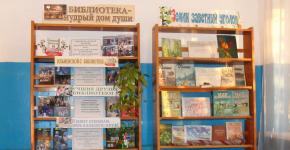Unusual exhibitions in the library. Library exhibition work
Unconventional forms of book exhibitions have appeared in libraries in recent decades. Given the increasing needs and increasingly diverse interests of readers, librarians strive to make exhibitions more interesting and attractive. For this, a variety of techniques are used. Those that have received the support and recognition of readers are developing and improving. So, in recent years, the following non-traditional forms of book exhibitions have been widely used in library practice:
Book exhibition discussion;
Book exhibition-dictionary;
Exhibition of one book (magazine, newspaper, publication);
Exhibition-quiz, exhibition-crossword, exhibition-competition;
Exhibition-game, exhibition-lotto
Dialogue exhibition:
Hobby exhibition,
Exhibition-exposition (exhibition-workshop, exhibition-studio, exhibition-pantry, exhibition-garden);
Reflection exhibition;
Recognition exhibition;
Exhibition symbol;
Exhibition dossier (literary dossier of the reader),
Benefit exhibition of the reader, etc.
What is a book exhibition-discussion? The purpose of the book exhibition-discussion is to arouse the readers' desire to argue, debate, express their opinion on any issue or topic. For this, literature should be presented at the exhibition, covering this problem from different points of view. Most often, exhibition-discussions are dedicated to a person, a historical or political person whose activities cannot be unambiguously assessed, or to any topic or problem that has not been solved at the moment.
An example of a personal exhibition-discussion: “Space aliens: pros and cons” Sections:
1. "Yes, they really arrive!"
2. "No, they exist only in our imagination."
There is much in the world, friend Horatio,
What our sages did not dream of.
W. Shakespeare
Or: "The truth is somewhere nearby."
The purpose of the exhibition is to interest readers with mysterious and sometimes inexplicable phenomena, introduce them to different points of view on them, arouse a desire to reflect on this topic, and express their opinion.
What is a book exhibition-dictionary for in libraries? The purpose of this exhibition is to explain the meaning of any terms and concepts, as well as provide additional information about them. A variety of concepts and terms can be chosen - economic (inflation, default), political (inauguration, impeachment), art history, literary studies, etc.
The names of sections of the exhibition are concepts and their definitions, taken from the dictionary and executed on separate sheets of paper in the same way as quotes. Nearby are books, articles from newspapers and magazines containing detailed information about these concepts.
An example of a book exhibition-dictionary: “From the piggy bank of a grandfather Literary critic”. The purpose of the exhibition is to explain the meaning of some literary terms, to introduce interesting materials that reveal their contents, which will help prepare an oral message for a lesson in literature, write an essay, and an abstract.
1. PROTOTYPE - a real person who served the author to create a literary hero, image, type.
2. Alias \u200b\u200b- an invented name or symbol with which the author signs his work.
3. Parody - a comic image of a work of art, style, genre.
4. PLAGIAT - literary theft, the publication of someone else's work or part thereof under its own name.
How to arrange an exhibition of one book? The goal is to interest readers with a particular book, this can be achieved if various materials are presented at the exhibition, which helps to reveal the contents of the book and contributes to a deeper understanding of it.
This may be the following information:
On the history of the creation of the book;
On the prototypes of the heroes of the work, their fate;
Literary analysis of the work, statements about it by critics and writers;
The stories of famous people and readers of the library about the role of this book in their life;
On the film adaptation of the work; stories of the director and actors about working on the film, etc.
The exhibition may also feature various editions of this book, illustrations made by different artists, photo frames from film adaptations, sheet music, cassettes with recording music for films, etc.
It is very important for such an exhibition to choose the right book. It should be bright, informative, interesting, not ordinary. It can be a classic - past centuries and modern. Or a local history book.
Why do libraries issue “exhibitions of forgotten books”? It would be more correct to call them - "exhibition of undeservedly forgotten books." The objective of such exhibitions is to recall good art and popular science books, which for some reason are not popular with readers. Especially great value of these exhibitions for readers-children. Many of them read modern children's literature and do not know at all the books that their parents read.
The exhibition can be called so - "Favorite children's books of our dads and mothers" or "These books were read by our grandmothers." Such exhibitions are very relevant not only because they contribute to the mutual understanding of generations. They help to return to modern children the books of a moral and ethical orientation, so necessary for their development - the works of Vladimir Zheleznikov, Vladislav Krapivin, Yuri Yakovlev, Albert Likhanov, Anatoly Aleksin.
What is a book exhibition-dialogue? A book exhibition-dialogue is a correspondence conversation, ‘correspondence communication between a reader and a librarian. Readers ask questions, librarians answer them using books.
Organization of the exhibition is preceded by a lot of preparatory work. About a month before its design, next to the issuing department, you can put a tetrahedron glued from thick paper (a triangular pyramid). On two sides write an appeal to readers:
Dear Reader! You are worried about hundreds of questions that you cannot answer yourself: about friendship, about love .... The book exhibition “Life poses problems” will help you find out about this and much more. You can write, without indicating your name, to ask questions that interest you. We will try to find answers to them in books and magazines.
On the third side of the tetrahedron, you can cut a gap where readers will drop notes with questions. Put paper and pencil next to the pyramid. Librarians read all questions, combine similar ones, then select literature that contains answers to them. The selected sources are arranged at the exhibition in sections, the names of which are questions asked by readers.
The dialogue exhibition is most effective in working with teenage readers and young people, who, due to age-related psychological characteristics, cannot ask the librarian their questions orally. Topics for such exhibitions can be very diverse - friendship, love, interpersonal relationships of adolescents with peers, parents, teachers, smoking, alcoholism, drug addiction.
Example: exhibition - dialogue "Ecology: anxieties and hopes".
I plucked a flower
And he wilted.
I caught a bug
And he died.
And then I realized
What to touch
To beauty
You can only with your heart ...
Is the planet in danger?
Complaint book of the forest.
You are responsible for all that you tamed ...
To live together or to die together? / Alarms of the native land /
Ecology of the soul / Raise the soul to good.
In what cases is it better to use a book exhibition quiz and a book exhibition crossword in the library? The purpose of these exhibitions is to stimulate the interest of readers-children in reading books on a certain topic, problem. Since many children have little or no motivation and desire to learn a topic, a book exhibition quiz comes to the aid of a librarian. Often she plays the role of a kind of “carrot”, with which the librarian “attracts” children to reading certain books.
The development technique of this exhibition is similar to the thematic one. The difference here is that the librarian makes questions, the answers to which children will find in the books presented at the exhibition. These questions are drawn up on a piece of paper and placed at the exhibition.
You can approach the design creatively. For example, to develop an exhibition-quiz “The miracle tree of Korney Chukovsky”. From a natural material, cardboard, paper, make a “miracle tree” and place it between two exhibition racks, on which various editions of Chukovsky’s books and information about the writer are presented. From paper, colored paper, cut out leaves, write quiz questions on them and attach them to the branches of the “miracle tree”. The most active readers who correctly answered all the quiz questions must be encouraged after summing up.
A crossword puzzle book exhibition is drawn up in the same way, but instead of quiz questions, a crossword puzzle is compiled, which the guys solve using books presented at the exhibition.
What is the difference from other exhibition-competitions? The goal is not only to stimulate interest in reading, but also to foster a reading culture. The competition, as a rule, consists of several stages, at each of which children are invited to perform different tasks. At the beginning, the tasks are relatively simple: read books from the exhibition, answer questions. At the next stages, the tasks become more complicated and acquire a creative character - to draw an illustration, write a review, essay, story, essay on the topic of the exhibition, make a craft, home-made book, etc. All information about the competition should be presented at the exhibition. After summing up, the works of all participants (or prize winners and winners of the contest) are exhibited at this or a special exhibition (for example, “We draw a fairy tale”).
What is a hobby exhibition? A hobby translated from English is a hobby, a favorite pastime for yourself, at your leisure. Some of our readers collect buttons, some beautifully embroider or burn wood, while others enthusiastically build mock-ups of cathedrals and churches from matches. With the consent and with the help of a reader who is fond of beadwork, an exhibition “Bead Fairy Tale” can be arranged in the library. The exhibition will feature books and articles on the history and technology of beadwork, various beadworks made by the reader, her tips for beginning craftsmen.
Instead of a quote, you can put the reader’s statement about the role and significance of this hobby in her life. At the exhibition, photographs of the craftswoman behind her favorite needlework and some of her biographical data will be appropriate.
An interesting exhibition will be a hobby of a reader who is keen on any personality, topic, problem (for example, the work of Viktor Tsoi) and collects material on this topic. With it, we can arrange an exhibition where we will present materials and documents from the personal collection of the reader. Information about this must necessarily be at the exhibition, and the reader can conduct conversations at the exhibition. There are no restrictions on the choice of a reader whose passion we present at a hobby exhibition. This may be a child reader, his parents, grandparents, maybe the librarian himself, or maybe the whole family.
Recently, book exhibitions, created jointly by the reader and the librarian, have been very popular in libraries. Such exhibitions are the result of a high level of their relationship. On the one hand, in this way the librarian thanks the reader for his many years of cooperation with the library, on the other hand, he shows readers what an interesting personality you can become, what creative heights you can achieve if you love the book and actively visit the library.
Such exhibitions include the exhibition dossier (“Literary dossier of the reader”, “From the reader's form ...”, etc.). Here are usually presented our reader’s favorite books, his portrait, autobiography, answers to questionnaire questions, statements about the role of the book and the library in his life, as well as reviews, opinions, impressions of the books read, tips and recommendations to other readers. Of particular interest to peer readers is the dossier of a teenage reader. It is at this age that the opinion of peers, not adults, plays a major role in choosing books to read.
Today in children's libraries such a visual form as a book exhibition-game is actively used. Its purpose is to attract to the book and reading through the game. For example, “Read - play”, “Read, master, play”, “Favorite books - favorite toys”, etc. At first, such exhibitions were designed mainly for preschoolers and primary school students. At the exhibition next to the books were placed toys depicting the heroes of books.
Most children of this age have a poor reading technique. They quickly get tired of reading, and then, they can take toys from the exhibition and play the situations they just read with them, and also come up with their own sequel. This not only helps the child take a break from reading, but also helps to foster a reading culture.
With the help of such an exhibition, one can hold “literary hide and seek” in the library. Before starting the toy from the exhibition, it is necessary to remove it to another exhibition rack or table. During the game, the librarian asks questions. A child who has guessed what kind of hero is in question calls his name, author and title of the book. Then he goes to the rack with toys, finds the guessed hero and puts him next to the book at the exhibition. Literary hide and seek ends when the last toy takes its place next to the book.
In recent years, the number of visitors, children who do not like and do not want to read, has significantly increased in children's libraries, and they come to the library because it is cozy, warm, bright, and allowed free of charge. As a rule, these are children from dysfunctional families who simply have nowhere else to go. Such children enjoy playing board games in a specially equipped playroom, browse magazines, comics. The book exhibition-game will help the librarian to attract such children to read, to interest the book.
A book exhibition-exposition is a synthesis of a library and museum exhibition. The items and accessories presented on it contribute to a deeper penetration into the topic the exhibition is dedicated to, a deeper understanding and perception of the documents presented on it. Moreover, there are much more items and accessories than at a regular library exhibition, and books and other documents successfully fit into the exposition. For example, you can arrange an exhibition-exhibition "Edible Loose Powder" in the form of a Russian stove, using old cast-iron, clay dishes, embroidered towels, homespun rugs for decoration. On a wide wooden bench near the “stove” to place wicker baskets in which to put books telling readers about the peculiarities of culture and life of the Russian people. On one of the baskets attach the name "Recipe basket", and fill the basket itself with books with recipes of Russian cuisine.
On top you can hang a poster-appeal: "Cook a dish for yourself, eat - good or bad." On the stove bench lay a doll - Kuzyu's little house, and next to it - a chest with culinary puzzles. Above the chest - the inscription: "Move, do not get tired and guess the riddles!"
For readers who want to test their knowledge of Russian cuisine, you can develop a crossword puzzle “Yummy!” Such an exhibition-exhibition will attract the attention of many readers and will be useful not only for children but also for adults. Near such an exhibition you can hold interesting conversations, high-profile readings, bibliographic reviews, quizzes, children's matinees and holidays. It will be appropriate to use elements of puppetry. For example, Kuzya’s housekeeper can “come to life”, get off his couch and invite children and adults to visit him, at the party “Visiting Kuzi’s House”, where he will be the main character.
You can develop and arrange an interesting exhibition devoted to dogs. Calling it - "A hundred friends of one hundred stripes" or "About those who bark." From plywood or cardboard “build” a dog kennel, next to it “put on a chain” a dog (soft toy).
Another dog can “guard” a box with books about dogs, the third - to offer readers a zoocrossword.
In addition to books, articles from newspapers and magazines, wall-mounted calendars, calendars and postcards with the image of dogs, children's crafts and drawings can be presented at the exhibition. To design a book exhibition-exhibition, a variety of, sometimes unexpected materials can be used. For example, photowall-paper with the image of a beautiful autumn forest.
Send your good work in the knowledge base is simple. Use the form below
Students, graduate students, young scientists who use the knowledge base in their studies and work will be very grateful to you.
Similar documents
The concept, classification and significance of exhibitions, their most important functions and tasks in a market economy. Problems and prospects of organizing interactive exhibitions. Directions and the role of increasing the effectiveness of promoting the exhibition with the help of promotional events.
thesis, added 10.21.2014
The formation and development of exhibitions and fairs, their classification, preparation and conduct: the purpose of participation, exhibition stand. The structure of the events of the business program of the exhibition. Information support of exhibitions and fairs. Participation in an international exhibition.
term paper, added 12/17/2007
Formation, development and concept of fairs and exhibitions. Exhibition activities in Russia. The purpose of the participation of the company in the work of fairs and exhibitions. Organizational stages of the Textillegprom exhibition. Commodity policy in international and national markets.
term paper, added 02/27/2009
Exhibition and fair activities as an element of public relations. Classification and importance of fairs and exhibitions for exhibitors and consumers. Study of the features of organizing and conducting exhibitions and fairs in production structures.
thesis, added 03.06.2012
Characteristics of the design features of the exhibition area and exhibition stand. Placement of promotional materials. The work of the staff of a travel company during the exhibition. The main functions of standers. Communication with visitors after the end of the exhibition.
test, added 07/27/2013
The concept, classification and significance of exhibitions and fairs, their formation and development, modern concept. Exhibition activity among marketing tools. The largest international tourism exhibitions and exchanges, directions for their improvement.
term paper added on 06/09/2011
The experience of organizing art exhibitions as a form of socio-cultural service in Russia. Promotion of art exhibitions. Exhibition halls as art institutions. Exhibitions in St. Petersburg, the author's project of organizing art exhibitions in the art hotel "Trezzini".
thesis, added 03.19.2012
Advantages of exhibitions and their subjects: multidisciplinary, industry, specialized. The value of exhibitions for the exhibitor. The objectives of the exhibition activities of the company and visitors. Decision making on exposure. Organization of participation in the exhibition.
Book Show NamesTo help the school curriculum
"Want to know everything"
"To help teachers of literature"
“Everything that is unknown is terribly interesting”
"By continents and countries"
"The geography of continents, oceans and seas"
“Russia. Russia. Russian empire"
“Every line breathes history”
"History in the faces"
"Two steps from the textbook"
“My tongue is my friend”
“Your friend forever”
“Language is the confession of the people”
“With a book in the world of interesting sciences”
“Behind the pages of the textbook”
"For Know-it -ins and Dunno"
“Knowing the world”
“Living as life” (about Russian)
“The reference kingdom is a wise state”
About books and reading
“With a book on life”
“The book is in your hands”
"Creative reader"
"Smart reader"
“We read, think, reason”
“We read, discuss, create”
"To you, book lovers"
“Foreign writers to children”
"Humor in children's books"
"On vacation with a book"
"Aloud. Loud. Inwardly. About us!"
“Favorite books of families”
“Open the book, and miracles begin”
“We read fairy tales, watch fairy tales”
Encore Reading
“Second profession is a reader”
“Each book is about you, each is for you, just peer”
Book News
“Books that everyone knows”
“Miracle is the name of the book”
"Library - book - modern reader"
“Good lyre” (novelties of modern literature for children)
“The book I want to talk about”
“Grandparents read these books”
“Good wise book”
To the anniversaries of writers and poets
“In this world, I am only a passer-by” (S. Yesenin)
“To you, O Motherland, I composed that song”
"My land, pensive and gentle"
“Golden foliage spun”
“I bless all that was” (A. Blok)
“A disturbed soul” (V. Shukshin)
“The music of love is higher” (B. Okudzhava)
“He told people the truth with a guitar” (V.Vysotsky)
"The double of his time"
“Frankly speaking” (L.Rubalsky)
“And we will still love” (E. Asadov)
“Poet, writer, illustrator” (E. Charushin)
“The Merry Writer” (N. Nosov)
“I was given a name at baptism - Anna” (A. Akhmatova)
“Pages of a rebellious life” (M. Lermontov)
“These lines will be a monument to me” (N. Gumilyov)
“The rowan lighted up with a red brush” (M. Tsvetaeva)
About etiquette
"Times and manners"
"Etiquette for every day"
"Politeness for every day"
“Let's be polite”
"Good manners lessons"
"Courtesy lessons"
Ethical Grammar
“About beauty, fashion and good taste”
"A cultured person is ..."
"His Majesty Etiquette"
"Elegance, beauty, charm"
Fairy tales
"In the world of fairy tales"
"This good old fairy tale"
"A Tale - Clever and Lovely"
“Visiting a fairy tale”
"We draw a fairy tale"
"Journey to the fairy glade"
"Journey to a fairy tale"
“There, on unknown paths”
“Let's play a fairy tale”
“In some kingdom”
“The wonderful world of fairy tales”
"The magical world of fairy tales"
"Tales of the Good Wizard"
"Tales of the peoples of the world"
"Tales travel the world"
"Dreamland"
"On the roads of fairy tales"
"Tales of the Udmurt people"
“Oh, these tales”
About health
“If you want to be healthy”
"Healthy lifestyle"
"Beauty, health, youth"
“Your health is in your hands”
"Longevity is real and possible"
“Protect your health”
“Take care of your health from a young age”
“Grow Healthy”
“You will be healthy - you will get everything”
"Be healthy"
“A healthy holiday every day”
Nature and ecology
“With love for nature”
“Through a book - love of nature”
“A world to be understood and loved”
"The Edge of the Silver Springs"
"Ecology and the book"
“We and our smaller brothers”
“About the native land with love”
“Live, nature”
“Live Earth!”
"Living language of nature"
“I love Rossi forest noise”
“Man and nature: harmony or tragedy?”
“Our four-legged friends”
“We have only one land”
"Earth is our home"
“Our common home is nature”
“You and I need Earth”
“Earth is the home of humanity”
Ecological Bulletin
“Words, colors, sounds”
"Man and the environment"
"Ecology of the native land"
"Nature of the native land"
"Nature and we"
"Nature and man"
"Who lives around, what grows around"
"Forest and its protection"
“About Our Lesser Brothers”
“In the fate of nature is our fate”
“Let's give the planet a chance”
"Land that is not more beautiful"
“Earth in alarm”
“We destroy nature - we destroy ourselves”
“Know, love, take care”
"For the cleanliness of land and rivers, man is responsible"
"We and our Earth"
"Earth - a blue planet"
"Nature. Ecology. Literature."
"Secrets of the green forest"
“In Defense of Nature”
"Alarm bells"
"Ecology and children"
"Ecology and society"
"Ecology and everyday life: look around"
"Environmental problems: the severity of the situation"
“Love and Know the Udmurt Territory”
"The soul of nature is present in us"
"Caution - nature!"
“Enter another nature”
“To protect nature, you need to know it”
“Air, water, soil: their preservation”
"Animals are the heroes of books"
"Birds of our forests"
"Nature does not forgive mistakes"
"Love is vast for a small homeland"
“Our small homeland is a native village”
“In the interests of present and future generations”
"The story of all living things"
"Look around"
“When you walk along your native land”
“Be a friend to a flower, a tree, a beast, a man”
“Seven pages about animals and birds”
Story
“Every line breathes history”
"History in the faces"
"The poetry of myth"
"We live and remember"
"Russian history"
"Heroes of our names"
"Those who are fond of history"
"Pages of History"
“Russia. Russia. Russian empire"
Family
"The world of my family"
"My family"
“Family matters”
“The warmth and light of the hearth”
"Our house"
“At the green lamp”
“Mom, Dad, I am a close-knit family”
“Favorite books of families”
"Homework"
"Under the roof of your house"
"Problems of family education"
"Your free time"
About love
"Lines of love"
“Love, love is a mysterious word”
“Love is the heart of everything”
"There is an eternal book of love"
"Poems about love"
"Song of love"
"But we will still love ..."
"Writers of Love"
About Pushkin
"The poet for all time"
"Pushkin and his era"
"The poet through the eyes of contemporaries"
"Pushkin's poetic echo"
“Let my soul open”
“Hope and love, dignity and honor”
“Pushkin in life”
“And life, and tears, and love”
"Pushkin and his Madonna"
"I loved you…"
"The beautiful and mysterious Pushkin"
"Pushkin and Natalie"
Periodicals
"Kaleidoscope of magazines"
"Newspapers and magazines for children"
“Children's magazines visiting children”
"Country Journal"
"What magazines talk about"
"Journey to the Country Journal"
“Hello, Country of Journalia”
“Scroll through us, read us, and we will teach you everything”
"Novelties of periodicals"
"News of the magazine world"
Art
“In the world of beauty”
“Traveling to the country of Inspiration”
"Travel to the country of creativity"
"Poetry and painting of romantics"
“Learning to see the beautiful”
“Look at the world with delighted eyes”
“Good through beauty”
"Dialogue of true goodness and beauty"
“Surprise and joy”
"In the world of dreams"
"The Art of Udmurtia"
"The beautiful around us"
Profession selection
“In the world of professions”
"Who to be?"
“I choose a profession”
"How to find yourself"
"Who am i?"
"Coming into life"
“Choose a profession”
"Your future profession"
“We are dear to the young everywhere”
"Traveling by Occupation"
"Kaleidoscope of professions"
“All works are good - choose to taste”
Unusual, unidentified
"Secrets uncovered and undisclosed"
"Obvious, but incomprehensible"
“Obvious - Incredible”
"Space trip"
"Secrets of magic and witchcraft"
Parenting and education
“Pedagogical search: experience, problems, finds”
"To help educators"
"Towards each other"
"To help the class teacher"
“We and our children”
"Lesson in a modern school"
“School: search along the way”
“From the textbook to the creative concept of the lesson”
"The path to the student"
We teach creativity "
“I am your student, you are my teacher”
Housekeeping and needlework
"Pts. Skillful hands
"For skillful hands"
“Skillful hands don't know boredom”
"Do it yourself"
"Handyman"
“Sew, knit, embroider”
"Good hands skill"
"City of masters"
"Homework"
“Tips of Mary the Artisan”
“Skillful hands and hard work will not create it yet”
“On long winter evenings: we sew, knit, embroider”
"Under the roof of your house"
Traffic rules
"The Alphabet of a Young Pedestrian"
“Everyone should know this.”
“On the rules of the movement without exception”
"Pedestrian alphabet"
"Red, Yellow, Green"
“Attention, road!”
miscellanea
“Courage, courage and honor”
“Meditations on the Highest Truth”
“Morality and legal responsibility”
“I, you, we”
"Travel to the country of Rodaria"
“Under the Sign of Zakhoder”
“Originally from childhood” (about S. Lagerlöf)
“CD in the library”
“Reason for fun: Dunno and Denisk”
“The life of wonderful people”
“Briefly about miscellaneous”
"To himself a psychologist"
“My childhood, a cherished country”
Everyone celebrates their professional holiday in different ways. However, everyone wants him to succeed and leave only fond memories. The librarians of our system this year, the Year of Culture, took an active part in the competition of book exhibitions about the library and the library"The best book exhibition for the All-Russian Library Day."
We bring to your attention a galaxy of these wonderful creations, perhaps they will once again cause pride in our library work, viewing them will give pleasant minutes, and perhaps some of the ideas will be further embodied in your work.
Books make you stop by them, squint with pleasure as you squint at the sun to look again with your eyes open.
K.A. Fedin
So get to know:

Head of the Ilmensky library No. 7 of MBUK "TsBS" (0,5 rates)
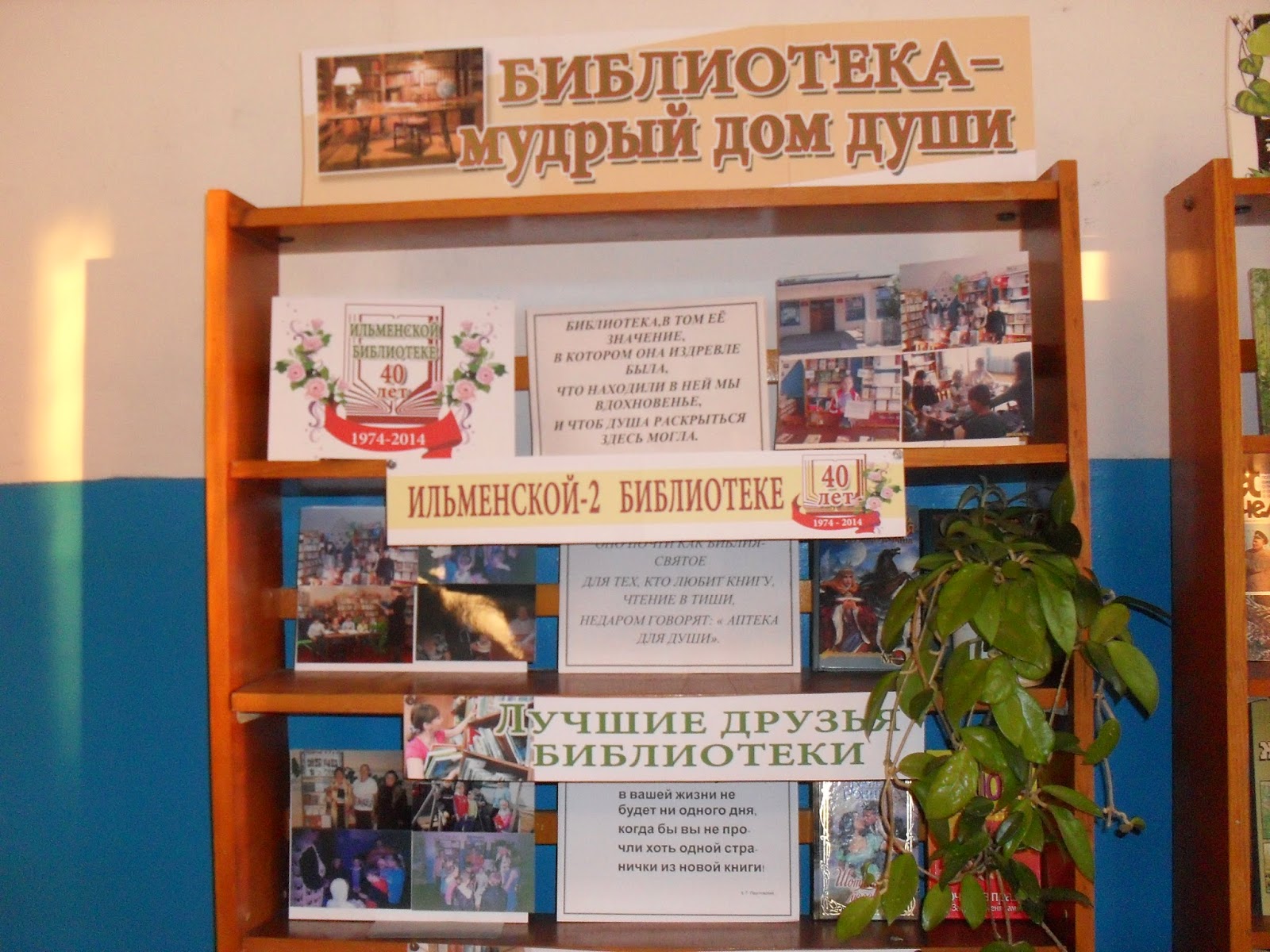
Ilmensky - 2 libraries - 40 years
Library best friends
And I open the book like a door to a big life
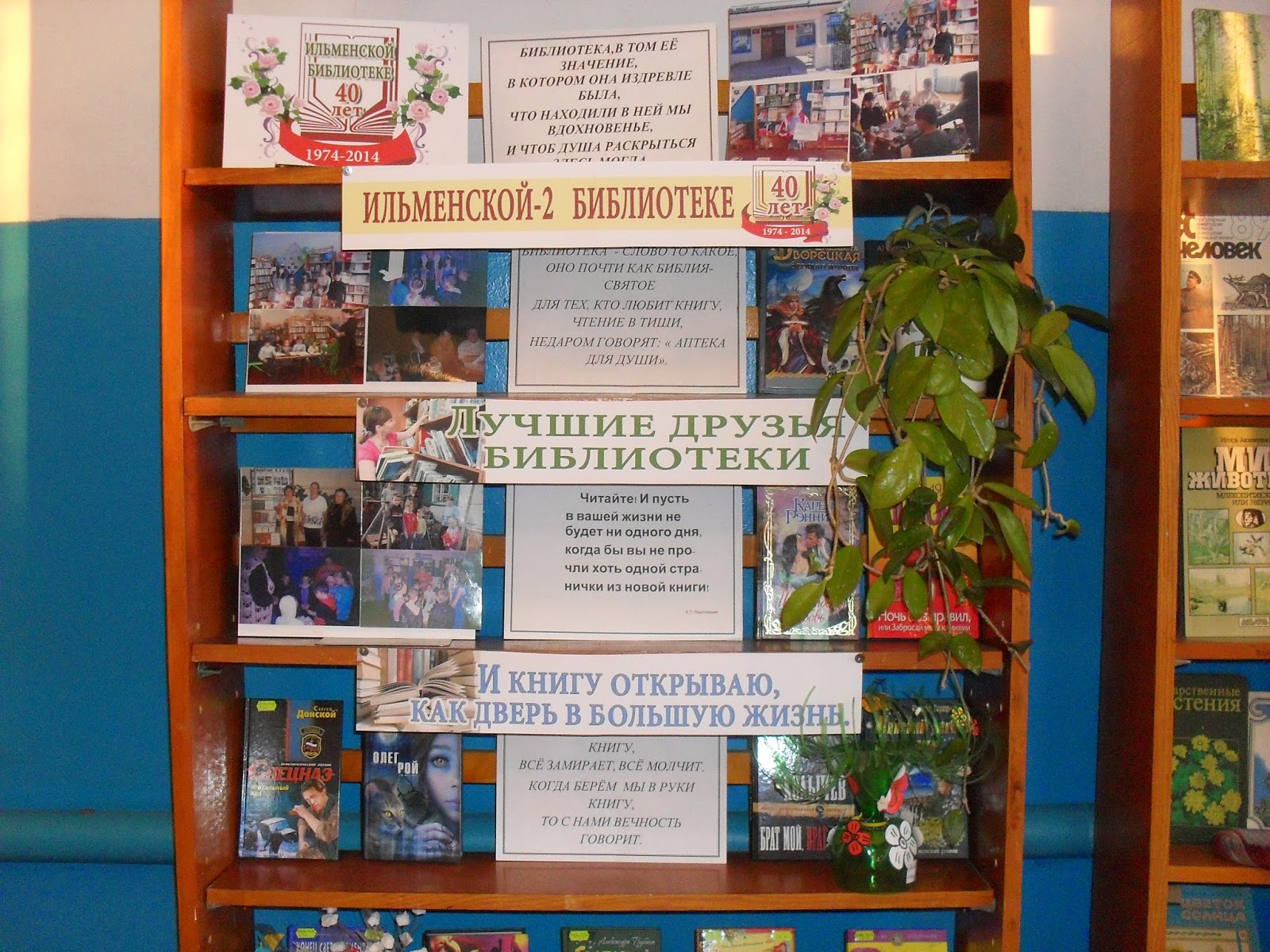 History of the best events
History of the best events
A.de Monzy
fr. the minister

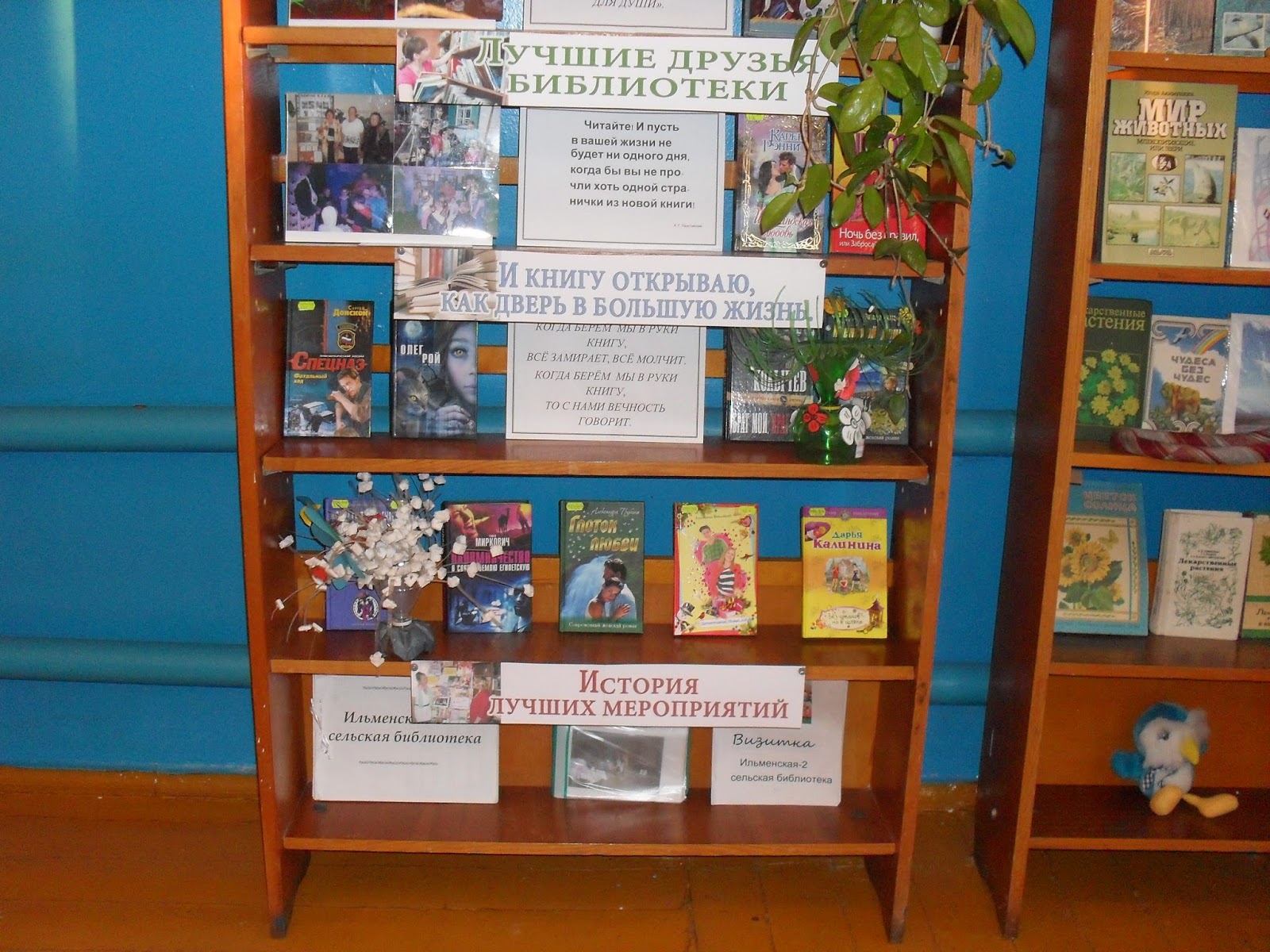
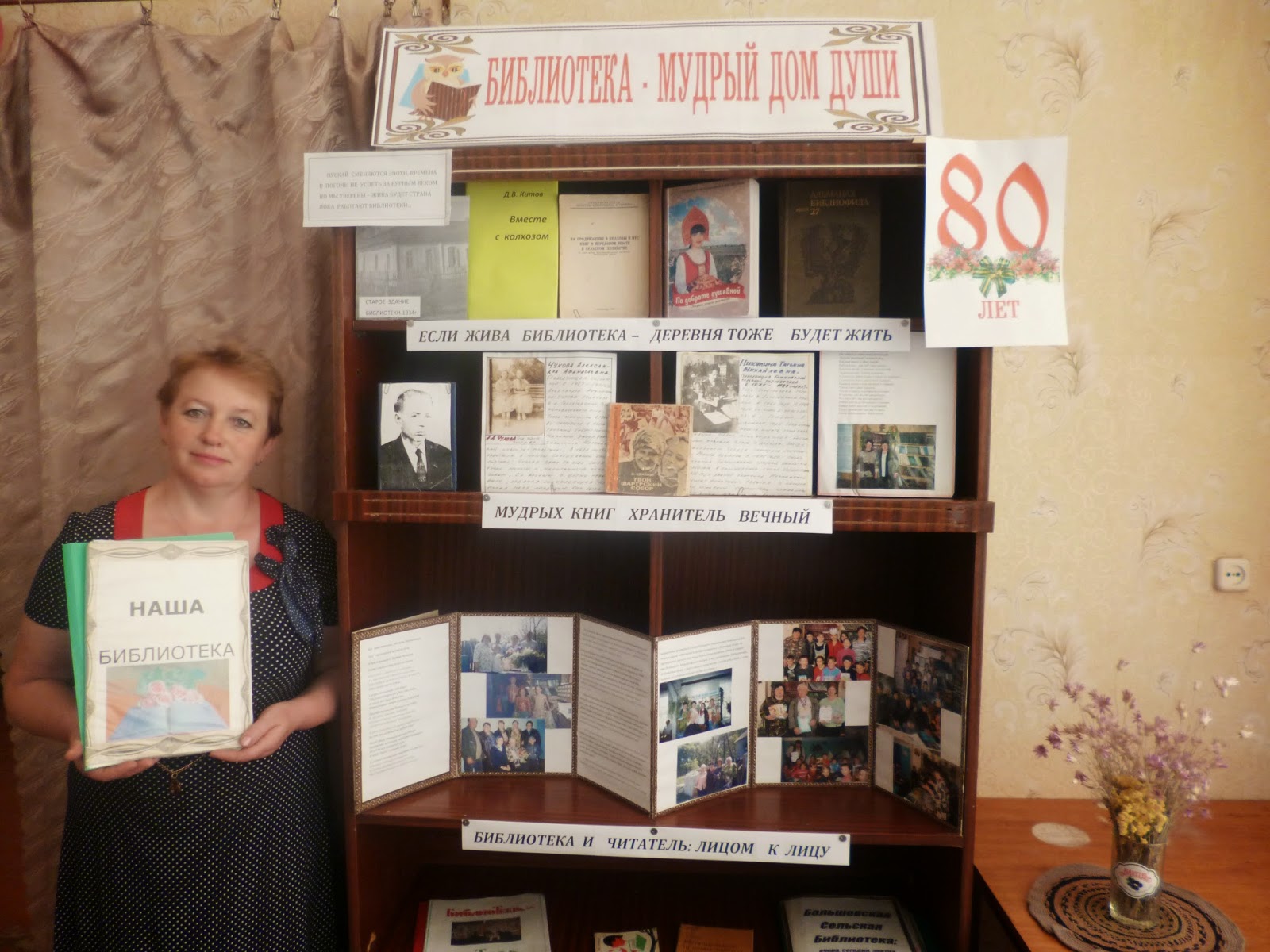
Collective Bolshov library№33 МУУК ЦБС (1,5 bids) toThe 80th anniversary of its foundinglibraries in 3 sections
1. If the library is alive - the village will also live!
2. The wise books are the keeper of the eternal.
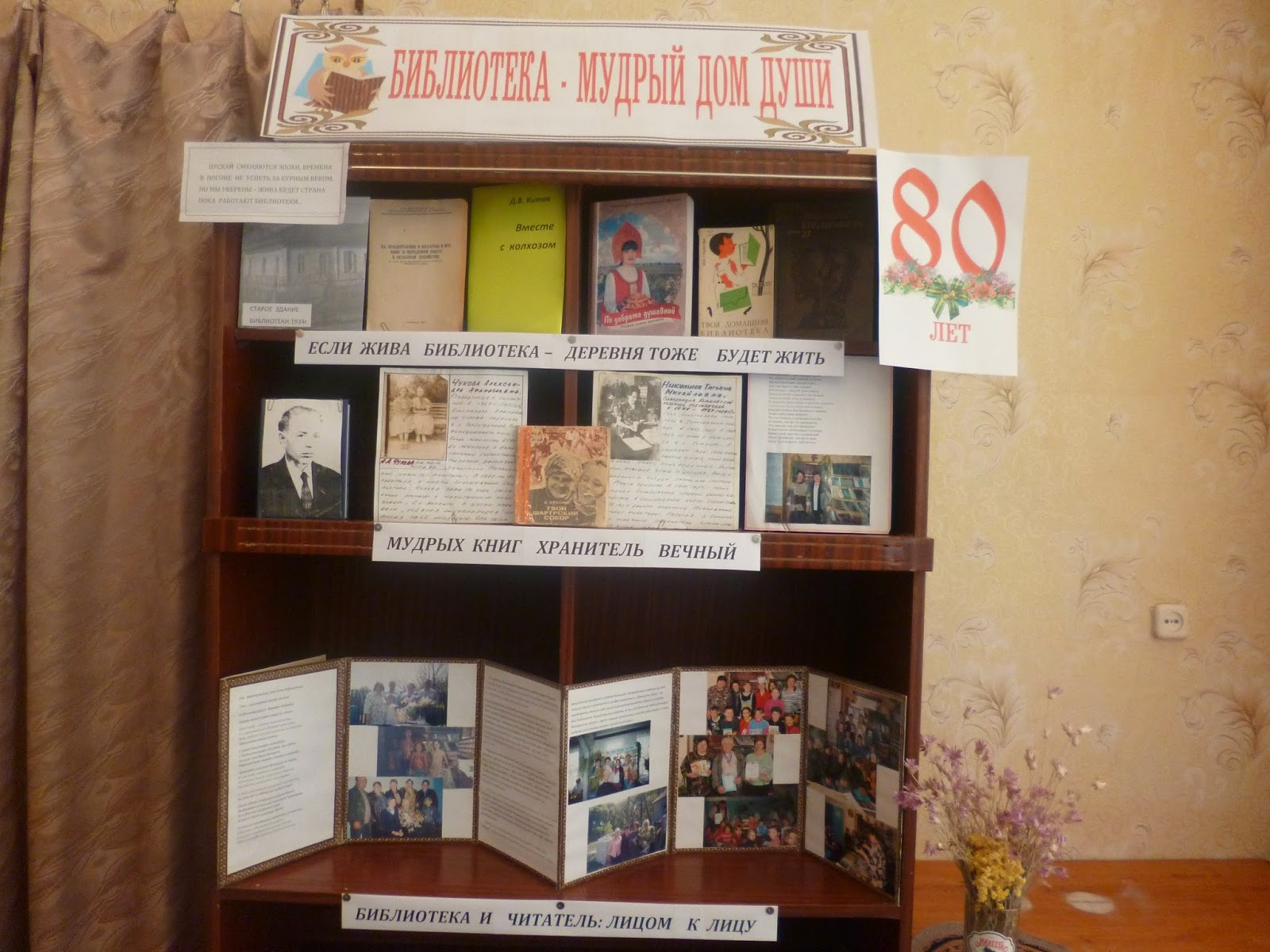 3.Library and reader: faceto face.
3.Library and reader: faceto face.
References for the exhibition:
Blinova, A. The adventures of Olya Iriskina in a book state: Script of a tetralized game program / A. Blinova // How to entertain guests.-2011.-№12.-p.26-30.
Buyanova, E.E. Dedication: verses about the Bolshov Library / E.E. Buyanova // Library-tech-pharmacy for the soul: Album.-2009.-p.1-2.
For the promotion of books on best practices in agriculture to the collective farms and MTS: from the experience of the Bolshov Rural Library in the Mikhailovsky District.-Volgograd:
Volgograd truth, 1965.-35s.
Kitov D.V. Together with the collective farm: from the experience of the Bolshov Rural Library.-M: Book, 1961.-50p.
Kramov V.V. Your Chart Cathedral: a teenager about the choice of professions / V.V. Kramov.-M: Education, 1979.-205p.
Sidorova S.I. Bolshov Rural Library // By the Goodness of Mind: Essays, Poems, Stories.-Mikhailovka, 2008.-p.226-228.
O. Urakova. We are poets yourself, compose with us, or Welcome to Rifmo-grad !: game-journey through the library / O. Urakova // Scenarios and repertoire.-2009.-
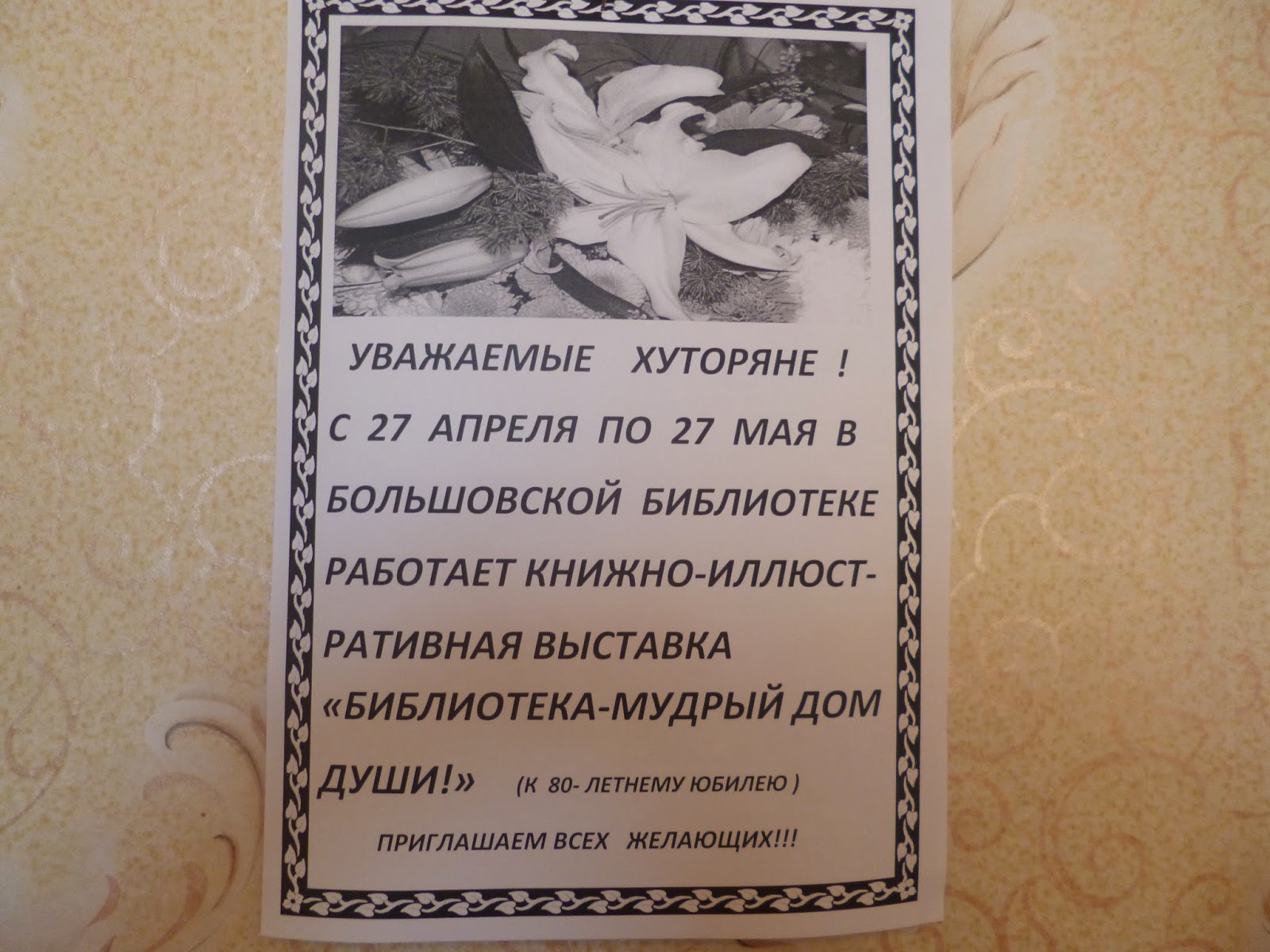 No. 13.-p.40-54.
No. 13.-p.40-54.
Book Exhibition Performance Evaluation: Time Periodexhibition work - 1 month. During this time, morefifty visitors were at our exhibition: 14 times a book was issued“Together with the collective farm”former librarianD.V. Kitova (from work experiencein the 60s). She was read the ataman of our farm, O.L. Makarikhin (there is material about his ancestors), the widow of a participant in the Battle of Stalingrad- Chuvilova A.E., farmers - Markova N.E., Pryanikova V.I., Trubitsyna A.T., Belyakova T.A. and many others - they’ll read everythingshe got into her youth ... etc. Many visitors of different agesviewed albums - “Mass work of Bolshovskayalibraries. Nowadays". Some teenage girls were interestedbooks about the professionthe librarian.
Conclusions and Prospectsfurther use of exhibition materials:
The materials of the exhibition will not lose their relevance in the future - this is the history of the foundation of our library, the work of our "cultural center" in different periods of its existence, and finally, the life of the farm populationfor many years.
Conclusion: LIBRARIES LIVED, LIVE AND WILL LIVE!
Katason library number 35 MBUK "CBS" (rate) Exhibition catalog
Exhibition Name"Pharmacy for the soul"

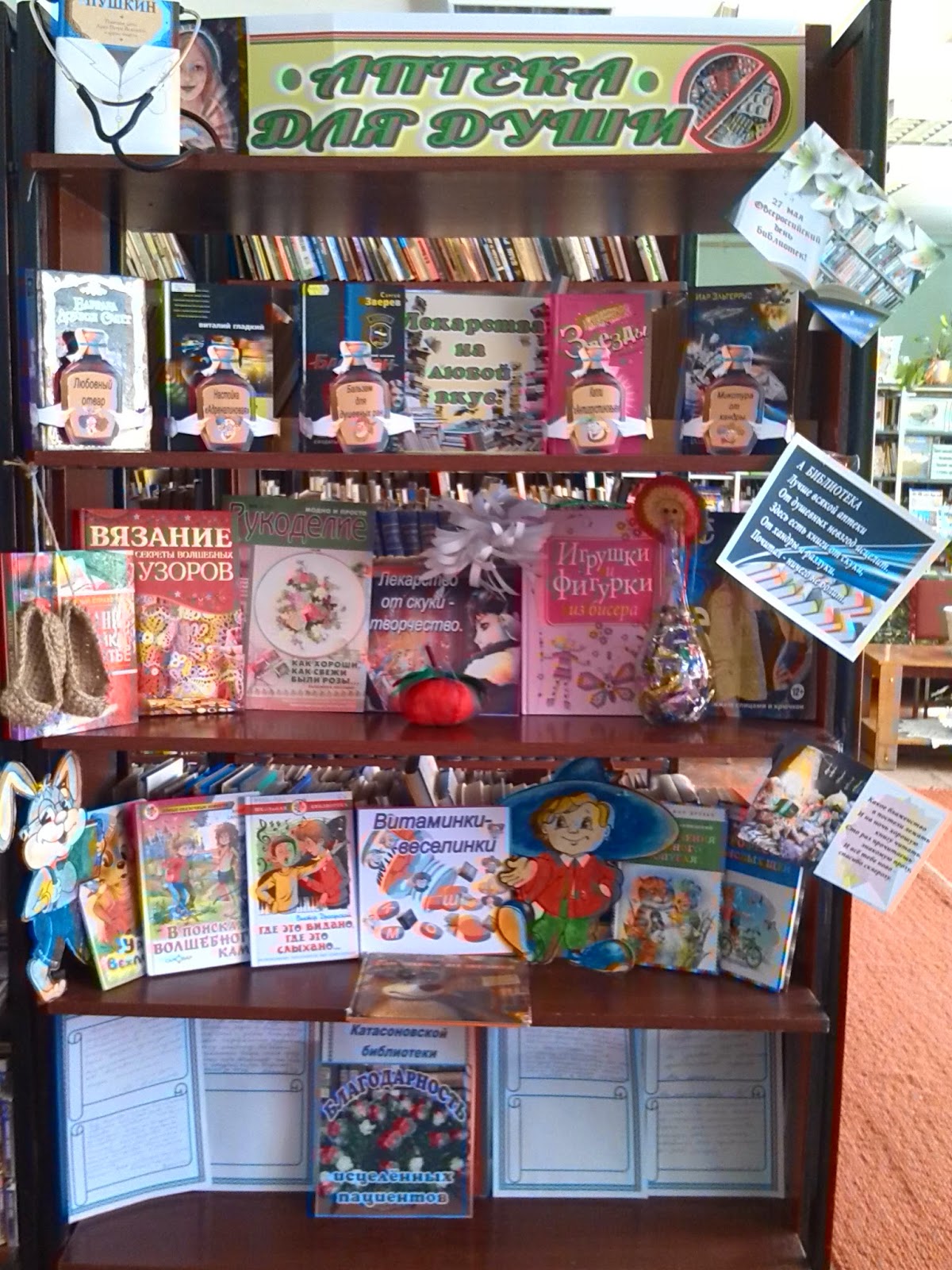
Book Exhibition Structure:
-Sections "Medicines for every taste"
"The cure for boredom - creativity"
Vitamins - Veselinki (fun books for children) Gratitude of Healed Patients
- Quotes
“A library is better than any pharmacy
From spiritual adversity heal.
From the spleen and separation.
I read - it hurts nothing ”
Yu.A. Orlova
"What bliss in bed to lie
You read familiar prose a hundred times
And everything is new to you - thanks to sclerosis ”
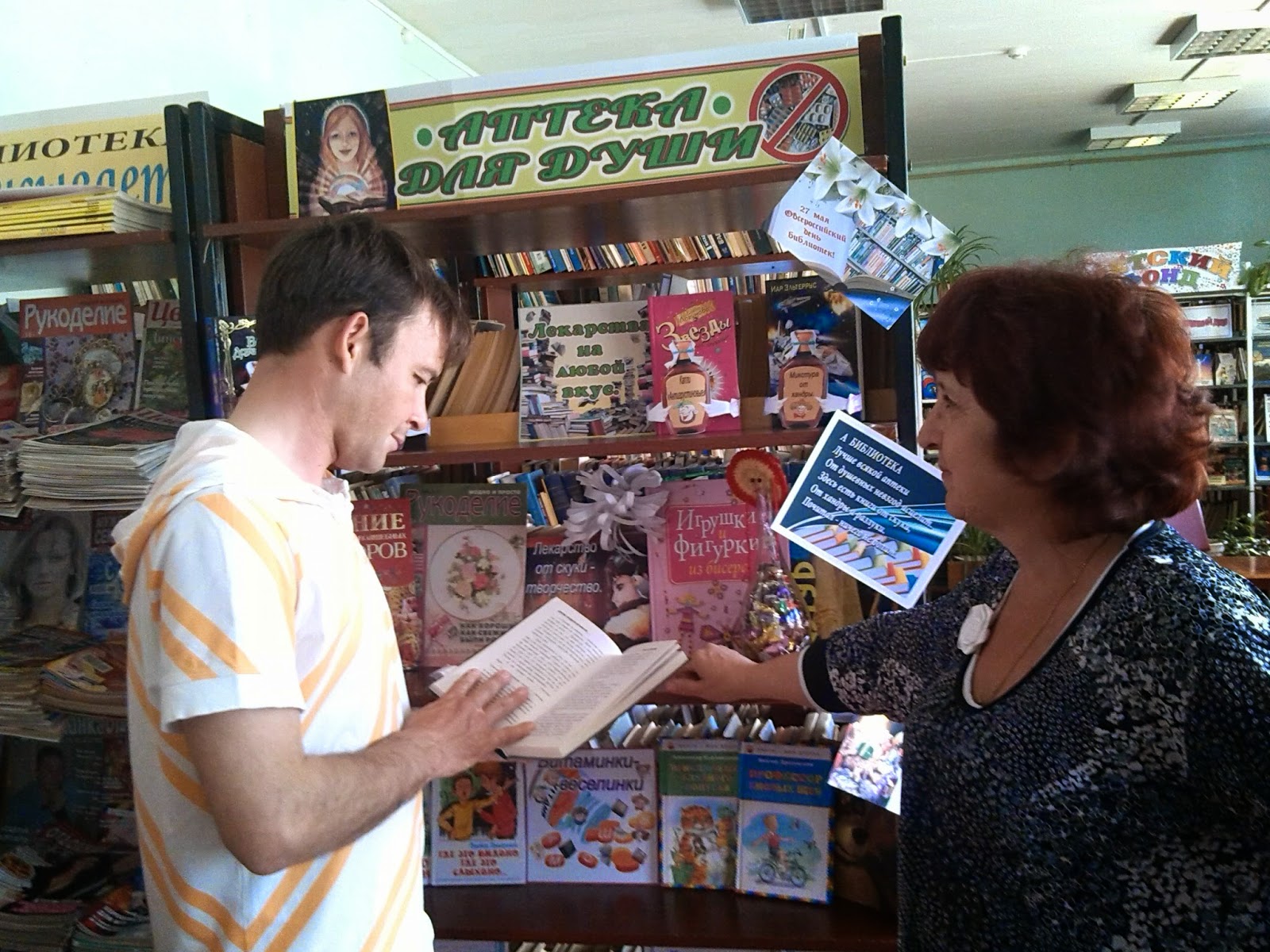
- Illustrative material Presentation “Book-healer”
Images of medicinal bottles with stickers: Drops “Anti-crustacean”, Potion from the spleen, “Love broth”, Tincture “Adrenaline”, “Balm for mental wounds”. Books hold these bottles in their hands.
- dunno and Bunny figures on a children's shelf
List of used literature for the exhibition:
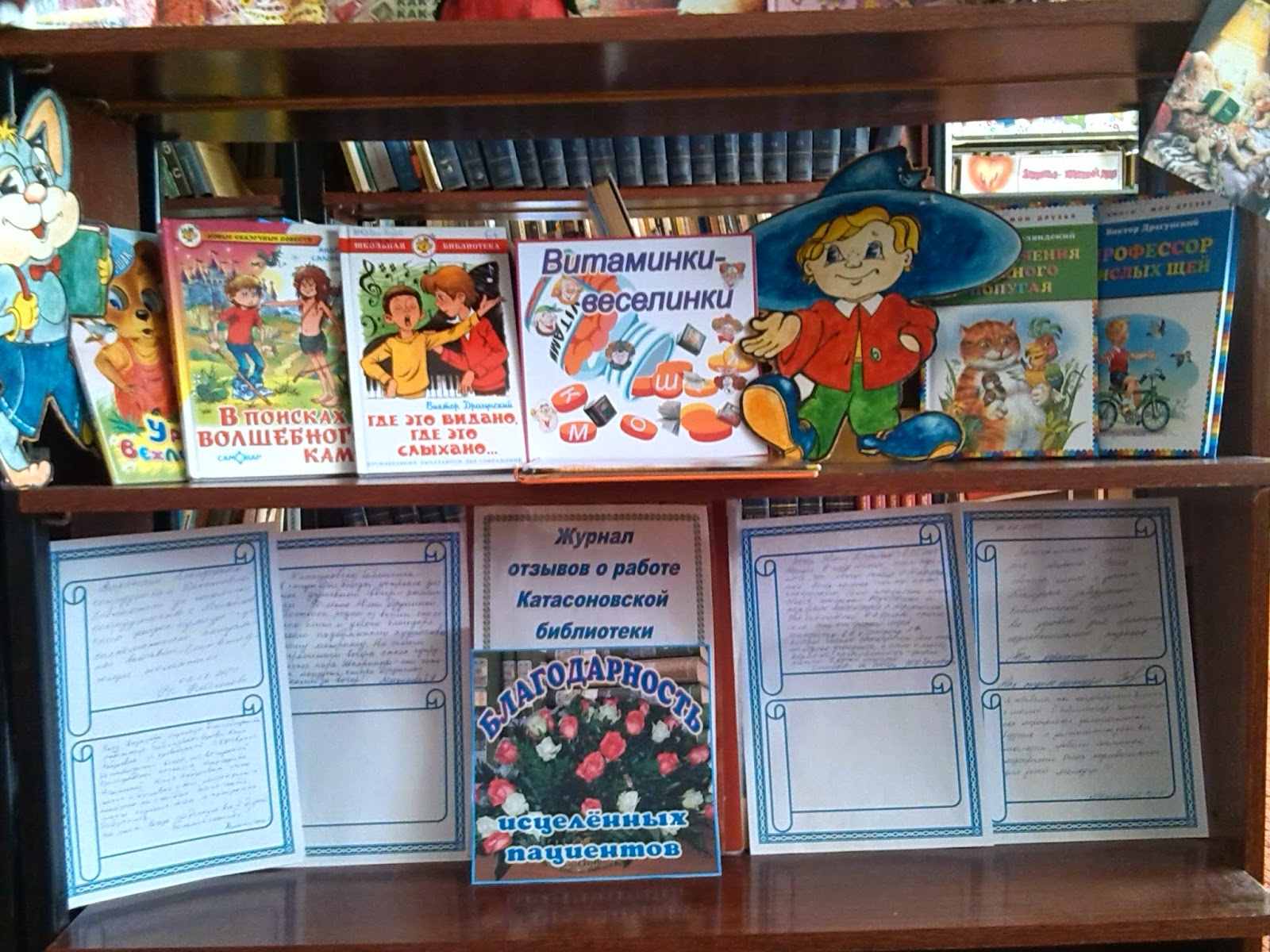
1. Balashova M. Ya. Knitting: the secrets of magic patterns / M. Ya. Balashova.- Minsk: Harvest, 2010 .-- 255 pp., Ill.
2. Knitting, cutting and sewing / ed. - comp. V. Nadezhdina.- Minsk: Harvest, 2009 .-- 479 p. - (Full reference).

